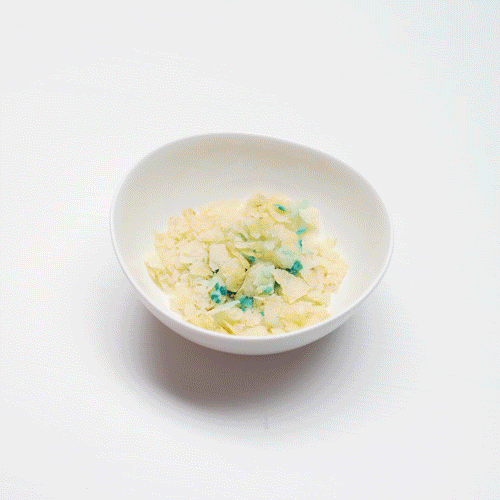Step-by-step tutorial
Fact
A patina is a green, blue, or brown film on the surface of copper and similar metals produced by oxidation over a long period of time.
Step 1
Gather your materials. Then, clean the copper with some dish soap and dry it thoroughly with a paper towel.

Tip
Try not to touch the copper once you’ve cleaned it. The oils from your fingers could interfere with the oxidation process! The best (and easiest) way to hold the copper is to pick it up around the edges.
Step 2
Crush up some potato chips and pour them in a bowl.

Step 3
Place the clean piece of copper into the center of the chips.

Step 4
Sprinkle a little salt on top of the copper.

Step 5
Cover the copper with a second layer of crushed chips.

Step 6
Pour enough vinegar into the bowl to soak the chips.

Step 7
Wait at least 4 hours. Then, pull out the copper! You should see a patina starting to form. If not, bury the copper back into the the potato chips and wait a little bit longer.

Tip
The longer you leave the copper soaking, the darker the patina will become! We left our copper overnight.
Learn more
Oxidation is a kind of chemical reaction between a metal and oxygen. You’ve seen it in action, and you’ve definitely seen its results, like rusted nails and tarnished teapots. But you probably never realized it was a chemical reaction, because unlike more lively reactions like mixing baking soda and vinegar, oxidation can take a long, long time to happen.
Oxidation happens naturally when oxygen in the air combines with bits of a metal. They only combine if there’s some water in the air, and acid or salt (like from seawater) will help speed things up. Together, the oxygen and the metal make a new compound called an oxide (because there’s oxygen in it, get it?). Lots of metals oxidize just from the weather; rusted iron is actually a chemical called iron oxide, and the blue-green verdigris on copper statues like the Statue of Liberty is copper oxide.
Oxidation can be a good thing or a bad thing depending on what metal you’re working with. For a copper statue or an aluminum can, the oxide forms a thin layer over the surface that protects the underlying metal. Once that layer is oxidized, the reaction can’t go any deeper. But for an iron gate or a steel rail, the oxide breaks apart the surface of the metal, letting the oxidation reaction eat deeper and deeper until there’s nothing left.
Once people realized that oxidation can be good for some metals, they figured out ways to make the reaction happen faster. With this chemistry project, you’ll be able to see oxidation happen overnight!
